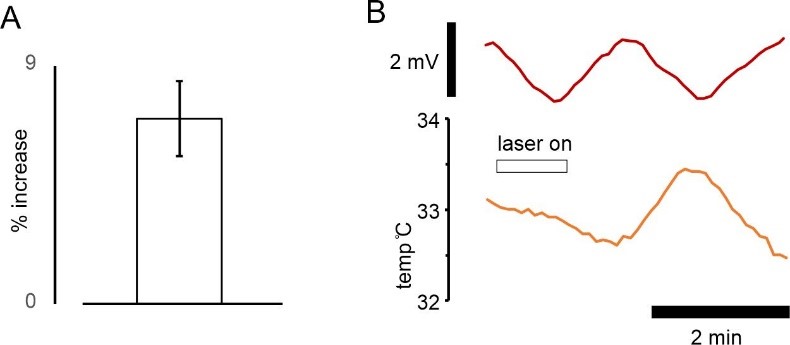Introduction. Impulse conduction in demyelinated central axons may fail as the body temperature rises because faster Na+ channel kinetics give rise to briefer action potentials, and a temperature dependent membrane potential moves the resting potential away from threshold (eg Coates et al 2015). Both mechanisms might contribute to conduction failure where the safety-factor for impulse conduction is lowered. Aims and methods. We have investigated the effects of applying infra-red light, generated by a laser-diode (1550 nm), to undamaged rat optic nerve, via a 9 mm diameter fibre-optic light guide. Optic nerves were isolated from Wistar or Sprague Dawley rats following a Home Office approved schedule 1 procedure, and maintained in a nerve-bath. Axon excitability was repeatedly measured in response to a constant-current stimulus delivered via a suction electrode, using the technique of computer controlled threshold-tracking, and maintaining a 50 % maximal response. Changes in axon membrane potential were recorded across a grease gap. Results. We report that the application of IR laser light reversibly increased threshold (400 mA diode driving current, n = 3, p = 0.038, one sample t-test, Fig. 1a). At constant light energy (350 mA driving current), the change in threshold was significantly raised by 99.81 ± 32.93 % following the application of 50 mM ZD7288, a blocker of Ih, (n = 5, p = 0.029, paired-t-test). These results are consistent with the laser light causing axonal hyperpolarization, that we have also recorded directly (Fig. 1b). Conclusion. At least a part of the action of IR laser light on optic nerve is associated with locally raised temperature and a membrane potential hyperpolarization, explained by the previously hypothesized role for electroneutral Na+ entry into optic nerve axons (Coates et al 2015; Kanagaratnam et al 2017). Fig.1 IR light affects optic nerve. a) Laser light application (400 mA driving current) raised current threshold by 7.01 ± 1.42% (mean ± SEM). b) Temperature fluctuations in flowing buffer solution (lower panel) mimic laser light application (350 mA driving current) on axon membrane potential (upper panel).
Future Physiology 2021 (Virutal) (2021) Proc Physiol Soc 47, PC65
Poster Communications: Infra-red laser light causes local hyperpolarization in rat optic nerve
Lavinia Austerschmidt1, Mark Baker1, Naseem Yusuf Mahmood1, Alyssa Marie Miller1
1 Blizard Institute QMUL, London, United Kingdom
View other abstracts by:
Where applicable, experiments conform with Society ethical requirements.

